The global synthetic spider silk proteins market is projected to grow from USD 950.5 million in 2025 to approximately USD 3,649.3 million by 2035, recording an absolute increase of USD 2,701.8 million over the forecast period. This translates into a total growth of 284.2%, with the market forecast to expand at a compound annual growth rate (CAGR) of 14.4% between 2025 and 2035.
The overall market size is expected to grow by nearly 3.84X during the same period, supported by the rising demand for advanced biomaterials in cosmetic and medical applications, increasing consumer preference for sustainable beauty products, and growing adoption of bioengineered proteins in skincare formulations.
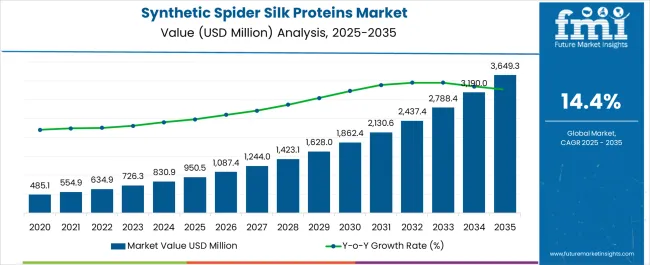
Between 2025 and 2030, the synthetic spider silk proteins market is projected to expand from USD 950.5 million to USD 1,863.2 million, resulting in a value increase of USD 912.7 million, which represents 33.8% of the total forecast growth for the decade. This phase of growth will be shaped by rising penetration of bioengineered materials in premium cosmetic formulations, increasing consumer awareness about sustainable beauty solutions, and growing adoption of spider silk proteins in wound care applications. Beauty brands and biotechnology companies are expanding their research and development capabilities to address the growing demand for high-performance, eco-friendly protein ingredients.
From 2030 to 2035, the market is forecast to grow from USD 1,863.2 million to USD 3,652.3 million, adding another USD 1,789.1 million, which constitutes 66.2% of the overall ten-year expansion. This period is expected to be characterized by expansion of commercial-scale production facilities, integration of advanced biotechnology processes, and development of new applications across medical and cosmetic sectors. The growing adoption of personalized skincare solutions and increasing regulatory approvals for bioengineered ingredients will drive demand for more sophisticated spider silk protein formulations.
Between 2020 and 2025, the synthetic spider silk proteins market experienced rapid expansion, driven by breakthrough developments in synthetic biology and increasing investment in biotechnology companies developing spider silk proteins. The market developed as cosmetic manufacturers recognized the superior properties of synthetic spider silk proteins compared to traditional ingredients. Research institutions and biotech companies began establishing partnerships to commercialize spider silk protein production for various applications.
| Metric | Value |
|---|---|
| Estimated Value in (2025E) | USD 950.5 million |
| Forecast Value in (2035F) | USD 3,652.3 million |
| Forecast CAGR (2025 to 2035) | 14.4% |
Market expansion is being supported by the unique properties of synthetic spider silk proteins, including exceptional strength, elasticity, and biocompatibility, making them ideal for advanced cosmetic and medical applications. These proteins offer superior performance in skincare formulations, providing enhanced firming effects, improved skin elasticity, and advanced wound healing properties. The growing consumer demand for clean-label, sustainable beauty products is driving adoption of bioengineered spider silk proteins as premium ingredients.
The increasing focus on biotechnology innovation and sustainable manufacturing processes is creating opportunities for synthetic spider silk protein applications across multiple industries. Cosmetic companies are increasingly seeking high-performance, eco-friendly ingredients that can differentiate their products in competitive markets. Regulatory support for biotechnology innovations and growing investment in synthetic biology platforms are establishing favorable conditions for market expansion and commercial scaling of spider silk protein production.
The market is segmented by function, protein type, product type, claim, channel, and region. By function, the market is divided into firming & elasticity, wound repair, moisturizing, and barrier protection. Based on protein type, the market is categorized into recombinant spider silk, peptide-mimetic silk, hybrid silk polymers, and biotech-engineered silk. In terms of product type, the market is segmented into serums, films/patches, creams, and gels.
By claim, the market is classified into clinical-grade, vegan, clean-label, and dermatologist-tested. By channel, the market is divided into e-commerce, dermatology clinics, pharmacies, and premium beauty retail. Regionally, the market is divided into major countries including China, United States, India, UK, Germany, and Japan.
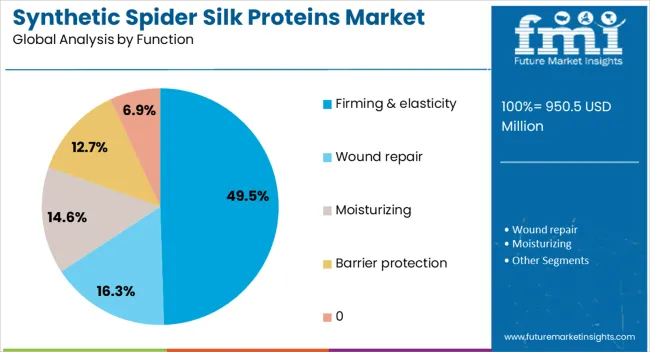
The firming & elasticity function is projected to account for 49.5% of the synthetic spider silk proteins market in 2025, reflecting its role as the leading application within this category. Spider silk proteins are renowned for their exceptional tensile strength, resilience, and biocompatibility, properties that translate into superior performance when applied in skincare. These proteins form a structural network that enhances skin firmness and elasticity, addressing key consumer concerns related to aging and skin laxity.
Unlike conventional actives, spider silk proteins operate through advanced protein-based mechanisms that mimic natural skin-support systems, offering visible and long-lasting results. The segment benefits from consumer willingness to invest in premium anti-aging solutions that promise efficacy rooted in biotechnology. With growing interest in protein-based actives and the pursuit of clinical-level skincare outcomes, firming & elasticity remains the most influential function driving adoption of synthetic spider silk proteins.
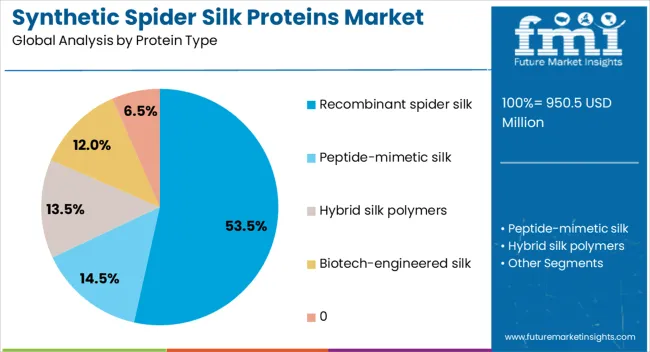
Recombinant spider silk proteins are expected to represent 53.5% of the market in 2025, underscoring their dominance as the most scalable and sustainable source of spider silk for cosmetic applications. Produced through advanced biotechnology methods such as microbial fermentation and genetic engineering, recombinant proteins offer consistent quality, safety, and supply reliability, critical advantages over natural spider silk, which is difficult to harvest in large volumes. These proteins retain the unique structural and mechanical benefits of native silk while enabling precise formulation control for skincare and medical uses.
The segment benefits from robust scientific validation and growing investment from biotech companies developing industrial-scale recombinant production platforms. As sustainability and reproducibility become central to ingredient sourcing, recombinant spider silk proteins are positioned as the gold standard for innovation, offering both commercial viability and strong alignment with consumer demand for high-tech, science-backed actives.
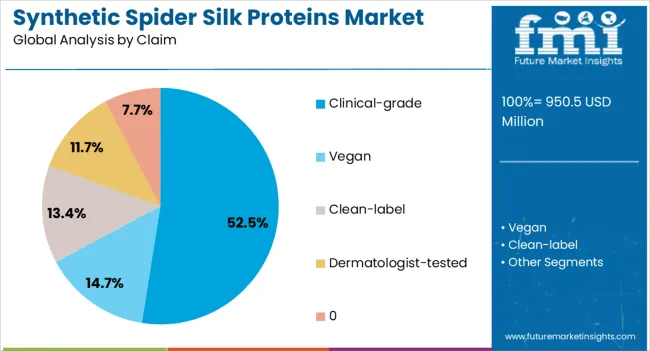
The clinical-grade claim is projected to account for 52.5% of the synthetic spider silk proteins market in 2025, reflecting rising consumer demand for scientifically validated, high-performance formulations. Clinical-grade products undergo rigorous testing to demonstrate safety, efficacy, and consistency, making them highly trusted in dermatology applications and premium skincare categories. Spider silk proteins lend themselves well to this positioning, as their biocompatibility and advanced structural benefits support claims of visible, clinically proven results in skin firmness, elasticity, and repair.
The segment is further strengthened by growing consumer sophistication and preference for evidence-based skincare solutions, where professional validation serves as a key purchase driver. Premium brands are increasingly leveraging clinical-grade positioning to differentiate products and command higher price points, ensuring that this segment remains a cornerstone in the adoption and credibility of synthetic spider silk protein innovations.
The synthetic spider silk proteins market is advancing rapidly due to breakthrough developments in synthetic biology and growing demand for sustainable, high-performance cosmetic ingredients. However, the market faces challenges including high production costs, complex manufacturing processes, and regulatory requirements for new biotechnology ingredients. Technological advancement and scale-up of production facilities continue to influence market development and commercial viability.
The growing development of scalable biotechnology platforms is enabling cost-effective production of synthetic spider silk proteins for commercial applications. Advanced fermentation technologies and genetic engineering processes are improving production efficiency while reducing manufacturing costs. These developments are making spider silk proteins more accessible for mainstream cosmetic and medical applications, expanding market opportunities across diverse product categories.
Modern biotechnology companies are incorporating advanced protein engineering techniques that enhance the properties and applications of synthetic spider silk proteins. Integration of computational design tools and directed evolution methods enables development of customized spider silk proteins with specific performance characteristics. Advanced engineering capabilities also support development of novel applications including drug delivery systems and advanced wound care materials.
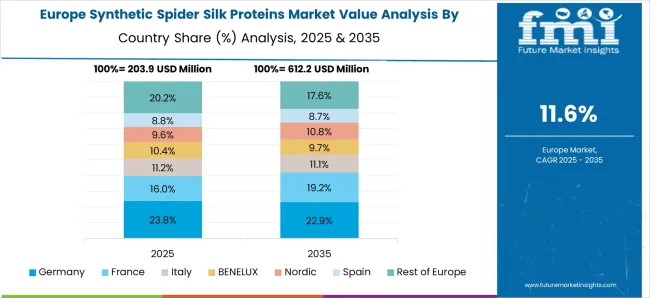
The synthetic spider silk proteins market in Europe demonstrates cutting-edge development across major economies with Germany establishing leadership through its advanced biotechnology capabilities and precision bioengineering expertise, supported by companies like AMSilk, BASF Care Creations, Evonik, and DSM-Firmenich pioneering innovative spider silk protein production technologies for premium cosmetic and textile applications.
France represents a significant market driven by its luxury beauty heritage and sophisticated understanding of high-performance ingredients, with companies like L'Oréal and Givaudan developing advanced spider silk protein formulations that combine French cosmetic artistry with revolutionary biomaterial science for next-generation skincare solutions.
The UK shows considerable interest in sustainable biotechnology and innovative materials science, while Italy and Spain exhibit growing fascination with biomimetic ingredients. Switzerland contributes through its precision biotechnology sector, while BENELUX countries focus on sustainable production methods. Eastern Europe and Nordic regions display emerging potential, driven by expanding biotechnology research capabilities and increasing consumer awareness of advanced biomaterial benefits in premium personal care applications.
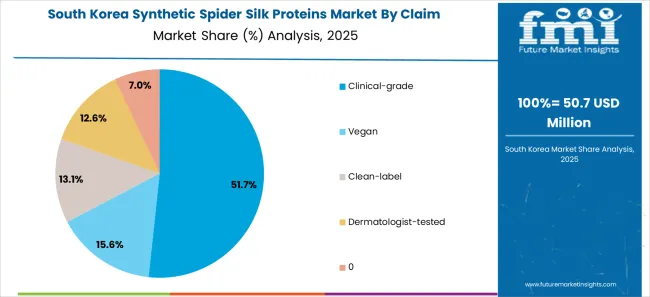
South Korea represents a dynamic innovation hub for synthetic spider silk proteins, positioning as a leading global market with technologically sophisticated consumers driving demand for cutting-edge biomaterial applications and next-generation beauty ingredients that push cosmetic science boundaries.
Companies like Spiber and Shiseido have established significant presence, developing revolutionary spider silk protein technologies that integrate with K-beauty principles of innovation and effectiveness in skincare formulations. The market benefits from extensive research capabilities in biotechnology, fermentation science, and advanced materials engineering, creating advantages for developing sophisticated spider silk protein production systems.
Strong domestic biotechnology infrastructure and cosmetics manufacturing capabilities support both local consumption and substantial export opportunities to global markets, particularly in luxury beauty segments. The integration of synthetic spider silk proteins with Korean expertise in fermented ingredients and bioprocessing, combined with consumer sophistication in understanding biomaterial benefits, positions the market as both a major consumer base and primary innovation catalyst for synthetic spider silk protein applications worldwide, driving future developments in biomimetic beauty solutions.
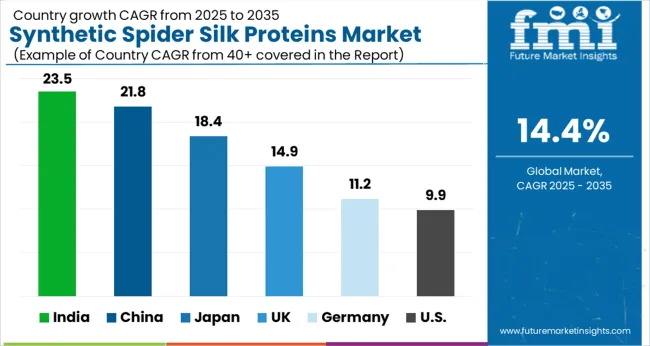
| Country | CAGR (2025 to 2035) |
|---|---|
| India | 23.5% |
| China | 21.8% |
| Japan | 18.4% |
| UK | 14.9% |
| Germany | 11.2% |
| United States | 9.9% |
The synthetic spider silk proteins market is experiencing exceptional growth globally, with India leading at a 23.5% CAGR through 2035, driven by expanding biotechnology sector, growing cosmetic market, and increasing investment in advanced materials research. China follows closely at 21.8%, supported by strong government support for biotechnology innovation, expanding beauty industry, and growing consumer demand for premium skincare products. Japan demonstrates robust growth at 18.4%, emphasizing advanced biotechnology capabilities and strong cosmetic industry presence. The UK and Germany show solid growth rates, while the United States, despite being a major market, shows more moderate growth as a mature market focusing on innovation and premium applications.
The report covers an in-depth analysis of 40+ countries; six top-performing OECD countries are highlighted below.
Revenue from synthetic spider silk proteins in China is projected to exhibit strong growth with a CAGR of 21.8% through 2035, driven by rapid advancement in biotechnology capabilities and increasing investment in synthetic biology platforms. The country's expanding beauty and personal care market is creating significant demand for innovative, high-performance ingredients. Major biotechnology companies and cosmetic manufacturers are establishing comprehensive research and development capabilities to capture growing market opportunities.
Revenue from synthetic spider silk proteins in India is expanding at a CAGR of 23.5%, supported by rapidly growing biotechnology industry and increasing consumer demand for premium skincare products. The country's expanding middle class and growing awareness of advanced cosmetic ingredients are driving market development. Research institutions and biotechnology companies are establishing capabilities to develop and commercialize spider silk protein applications.
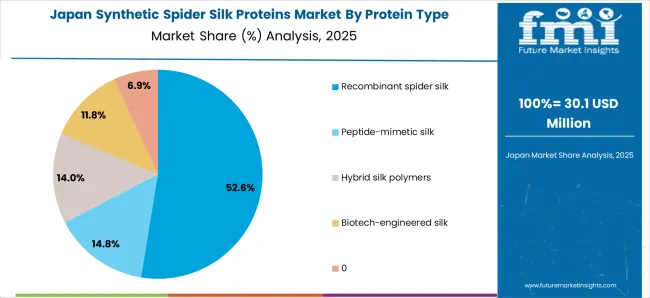
Revenue from synthetic spider silk proteins in Japan is growing at a CAGR of 18.4%, driven by the country's leadership in biotechnology innovation and strong cosmetic industry presence. Japanese companies are pioneering advanced production methods and developing sophisticated applications for spider silk proteins across cosmetic and medical sectors. The market benefits from strong research and development capabilities and consumer preference for high-quality, innovative products.
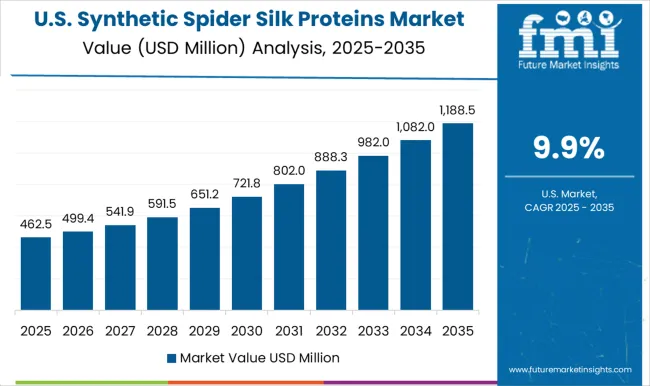
Demand for synthetic spider silk proteins in the United States is expanding at a CAGR of 9.9%, supported by strong biotechnology sector and growing demand for sustainable, high-performance cosmetic ingredients. American biotechnology companies are leading development of advanced production platforms and novel applications for spider silk proteins. The market is characterized by focus on premium positioning, scientific validation, and regulatory compliance.
Revenue from synthetic spider silk proteins in the UK is projected to grow at a CAGR of 14.9% through 2035, driven by strong consumer demand for sustainable, science-backed beauty solutions and increasing integration of bioengineered materials into premium skincare and haircare formulations. British beauty brands are emphasizing eco-conscious innovation and performance-driven ingredients, creating favorable conditions for synthetic spider silk adoption.
Revenue from synthetic spider silk proteins in Germany is projected to grow at a CAGR of 11.2% through 2035, supported by the country’s emphasis on scientific validation, ingredient safety, and compliance with strict EU cosmetic regulations. German consumers prioritize clinically proven efficacy and sustainable sourcing, positioning synthetic spider silk proteins as a premium ingredient for advanced skincare and personal care products.
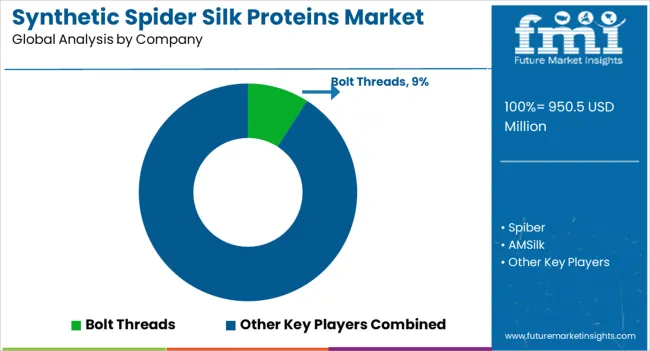
The synthetic spider silk proteins market is characterized by competition among biotechnology pioneers, established cosmetic companies, and specialty ingredient suppliers. Companies are investing in advanced biotechnology platforms, scalable production methods, regulatory compliance, and strategic partnerships to deliver innovative, high-performance spider silk protein solutions. Research and development capabilities, intellectual property portfolios, and commercial partnerships are central to establishing market leadership and sustainable competitive advantages.
Bolt Threads, USA-based biotechnology company, leads the market with 9.1% global value share in 2025, focusing on sustainable materials innovation and commercial-scale spider silk protein production. The company emphasizes advanced fermentation technologies and strategic partnerships with major beauty brands. Spiber, Japan-based, specializes in engineered spider silk proteins with applications across cosmetic and industrial sectors. AMSilk, Germany, develops recombinant spider silk proteins for medical and cosmetic applications with focus on European markets.
Kraig Biocraft focuses on genetically engineered spider silk production using innovative biological systems. Shiseido and L'Oréal, major cosmetic companies, are integrating spider silk proteins into premium skincare formulations and investing in biotechnology partnerships. BASF Care Creations, DSM-Firmenich, Evonik, and Givaudan represent specialty ingredient suppliers developing spider silk protein solutions for cosmetic industry applications.
| Items | Values |
|---|---|
| Quantitative Units (2025) | USD 950.5 Million |
| Function | Firming & Elasticity, Wound Repair, Moisturizing, Barrier Protection |
| Protein Type | Recombinant Spider Silk, Peptide-mimetic Silk, Hybrid Silk Polymers, Biotech-engineered Silk |
| Product Type | Serums, Films/Patches, Creams, Gels |
| Claim | Clinical-grade, Vegan, Clean-label, Dermatologist-tested |
| Channel | E-commerce, Dermatology Clinics, Pharmacies, Premium Beauty Retail |
| Regions Covered | North America, Europe, Asia Pacific, Latin America, Middle East & Africa |
| Countries Covered | China, United States, India, United Kingdom, Germany, Japan |
| Key Companies Profiled | Bolt Threads, Spiber, AMSilk, Kraig Biocraft, Shiseido, L'Oréal, BASF Care Creations, DSM-Firmenich, Evonik, and Givaudan |
| Additional Attributes | Dollar sales by protein design and production method, regional demand trends, competitive landscape, buyer preferences for performance versus sustainability attributes, integration with advanced textiles/biomedicine positioning, innovations in fermentation platforms, fiber spinning, and closed-loop recycling systems |
Channel:
The global synthetic spider silk proteins market is estimated to be valued at USD 950.5 million in 2025.
The market size for the synthetic spider silk proteins market is projected to reach USD 3,649.3 million by 2035.
The synthetic spider silk proteins market is expected to grow at a 14.4% CAGR between 2025 and 2035.
The key product types in synthetic spider silk proteins market are recombinant spider silk , peptide-mimetic silk, hybrid silk polymers, biotech-engineered silk and .
In terms of claim , clinical-grade segment to command 52.5% share in the synthetic spider silk proteins market in 2025.






Our Research Products

The "Full Research Suite" delivers actionable market intel, deep dives on markets or technologies, so clients act faster, cut risk, and unlock growth.

The Leaderboard benchmarks and ranks top vendors, classifying them as Established Leaders, Leading Challengers, or Disruptors & Challengers.

Locates where complements amplify value and substitutes erode it, forecasting net impact by horizon

We deliver granular, decision-grade intel: market sizing, 5-year forecasts, pricing, adoption, usage, revenue, and operational KPIs—plus competitor tracking, regulation, and value chains—across 60 countries broadly.

Spot the shifts before they hit your P&L. We track inflection points, adoption curves, pricing moves, and ecosystem plays to show where demand is heading, why it is changing, and what to do next across high-growth markets and disruptive tech

Real-time reads of user behavior. We track shifting priorities, perceptions of today’s and next-gen services, and provider experience, then pace how fast tech moves from trial to adoption, blending buyer, consumer, and channel inputs with social signals (#WhySwitch, #UX).

Partner with our analyst team to build a custom report designed around your business priorities. From analysing market trends to assessing competitors or crafting bespoke datasets, we tailor insights to your needs.
Supplier Intelligence
Discovery & Profiling
Capacity & Footprint
Performance & Risk
Compliance & Governance
Commercial Readiness
Who Supplies Whom
Scorecards & Shortlists
Playbooks & Docs
Category Intelligence
Definition & Scope
Demand & Use Cases
Cost Drivers
Market Structure
Supply Chain Map
Trade & Policy
Operating Norms
Deliverables
Buyer Intelligence
Account Basics
Spend & Scope
Procurement Model
Vendor Requirements
Terms & Policies
Entry Strategy
Pain Points & Triggers
Outputs
Pricing Analysis
Benchmarks
Trends
Should-Cost
Indexation
Landed Cost
Commercial Terms
Deliverables
Brand Analysis
Positioning & Value Prop
Share & Presence
Customer Evidence
Go-to-Market
Digital & Reputation
Compliance & Trust
KPIs & Gaps
Outputs
Full Research Suite comprises of:
Market outlook & trends analysis
Interviews & case studies
Strategic recommendations
Vendor profiles & capabilities analysis
5-year forecasts
8 regions and 60+ country-level data splits
Market segment data splits
12 months of continuous data updates
DELIVERED AS:
PDF EXCEL ONLINE
Synthetic Dye Market Forecast Outlook 2025 to 2035
Synthetic Data Generation Market Size and Share Forecast Outlook 2025 to 2035
Synthetic Biology Market Size and Share Forecast Outlook 2025 to 2035
Synthetic Abrasives Market Size and Share Forecast Outlook 2025 to 2035
Synthetic Zeolite Y Adsorbent Market Size and Share Forecast Outlook 2025 to 2035
Synthetic Musk Market Size and Share Forecast Outlook 2025 to 2035
Synthetic Tackifiers Market Size and Share Forecast Outlook 2025 to 2035
Synthetic Polymer Wax Market Size and Share Forecast Outlook 2025 to 2035
Synthetic Aperture Radar (SAR) Market Size and Share Forecast Outlook 2025 to 2035
Synthetic Diamond Market Size and Share Forecast Outlook 2025 to 2035
Synthetic Turf Market Size and Share Forecast Outlook 2025 to 2035
Synthetic Food Market Size and Share Forecast Outlook 2025 to 2035
Synthetic Polyisoprene Rubber Market Report – Trends & Innovations 2025–2035
Synthetic and Bio Emulsion Polymer Market Size and Share Forecast Outlook 2025 to 2035
Synthetic And Bio Based PMMA Polymethyl Methacrylate Size Market Size and Share Forecast Outlook 2025 to 2035
Synthetic Quartz Market Size and Share Forecast Outlook 2025 to 2035
Synthetic Leather Market Forecast & Growth 2025 to 2035
Synthetic Quartz Industry Analysis in Japan - Size, Share, & Forecast Outlook 2025 to 2035
Synthetic Food Color Market Analysis - Size, Share, and Forecast Outlook 2025 to 2035
Synthetic Paper Market Insights - Growth & Trends Forecast 2025 to 2035

Thank you!
You will receive an email from our Business Development Manager. Please be sure to check your SPAM/JUNK folder too.
Chat With
MaRIA